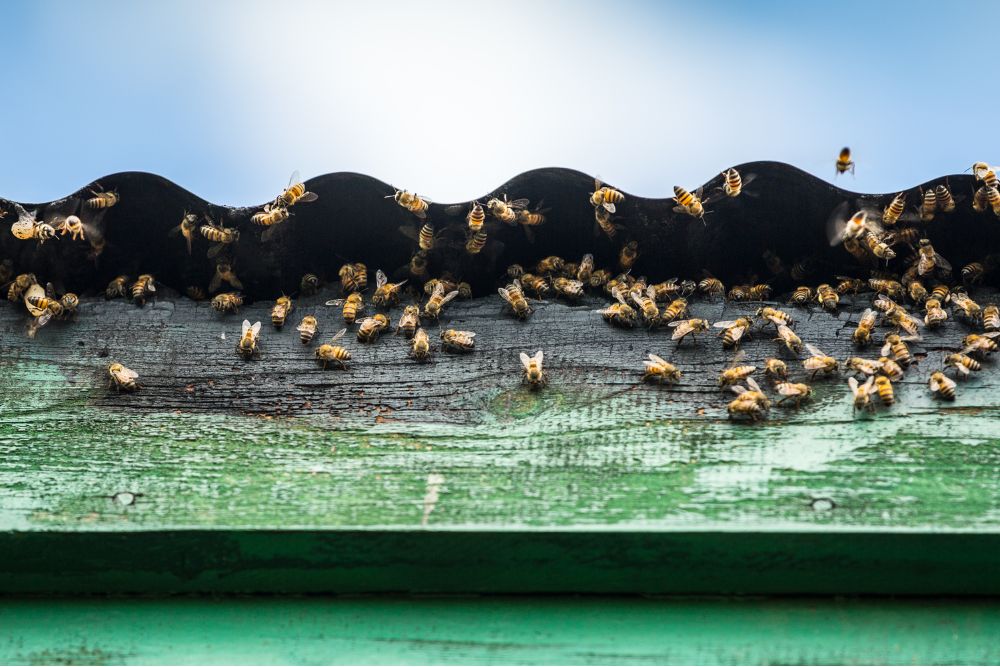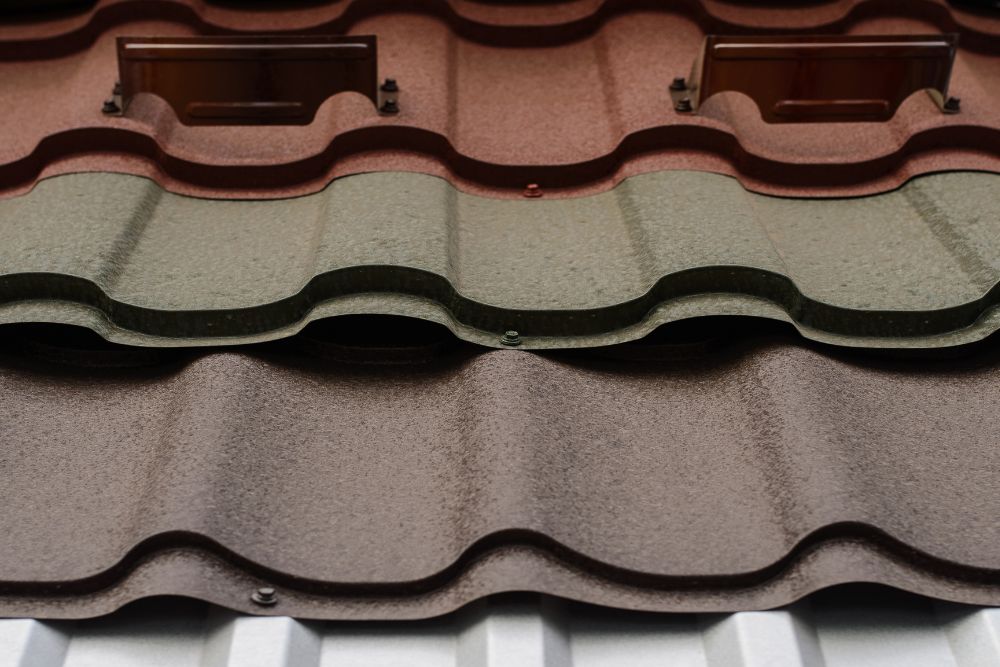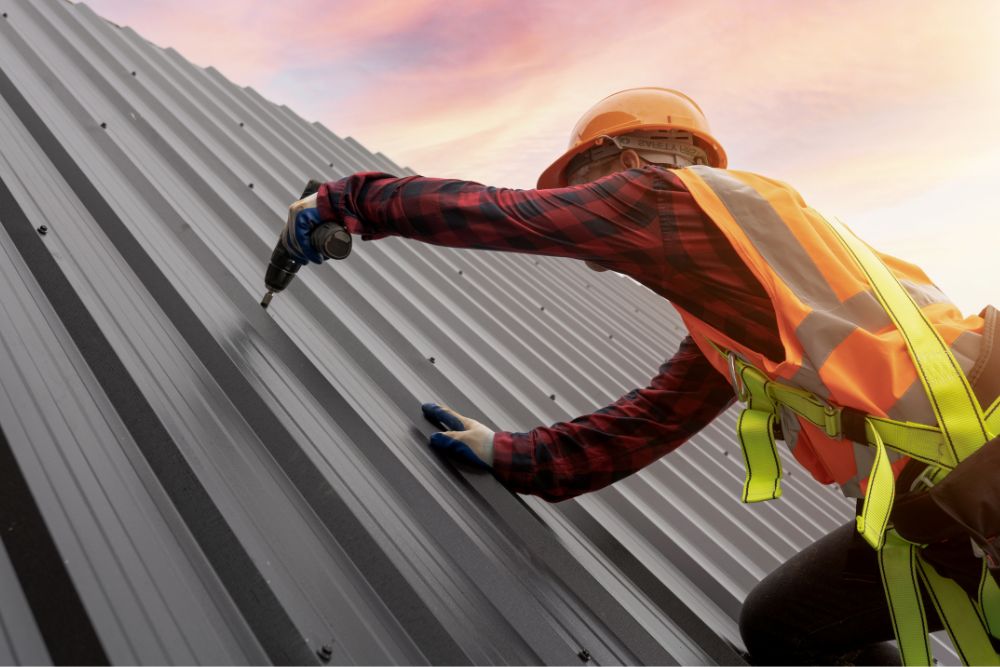Picture the gentle buzz of bees echoing through the walls of your house on a sunny Florida day. Finding a bee hive in your roof can be worrying, but it’s important to know how to deal with it.
Understanding bee behavior and safely clearing the area are key steps to keep your family and the bees safe.
Keep reading to learn what to do if you discover a bee hive in your roof in Florida.
Understanding Bee Behavior
When you have a bee hive in your roof in Florida, it’s important to understand bee behavior for effective control and prevention. Bee colonies are complex societies where scout bees play a key role in finding suitable nesting spots. These scouts search actively for locations between March and July and share their findings with the colony. If a scout bee discovers a dark, sheltered spot in your roof, it can lead to the formation of a bee colony if not dealt with promptly.
To stop bees from settling in your roof, it’s crucial to take proactive measures. Regular roof inspections can help you identify and seal potential entry points like small holes or cracks in siding materials. By removing a colony early, you can prevent further infestations and potential damage to your property. Understanding these behaviors and taking preventive actions will help you manage bee hives in your roof in Florida effectively.
Identifying the Hive Location
To find the hive location, watch where the bees are going in and out of your roof. Listen for buzzing noises and check for dark spots or stains that could show honey seepage. Look in your attic, eaves, or crawlspaces for signs of bees to locate the hive accurately.
Locating the Bee Hive
To find where bees have built their hive in your roof, watch for bees coming in and out of one spot. Listen for buzzing noises and check for dark stains or discoloration on your ceiling. Bees usually use one entry point to get to their hive, so keeping an eye on their movements can help you locate the hive.
If you hear buzzing inside your walls or roof, it could mean the hive is nearby. Dark stains or discoloration on your ceiling might be from honey leaking out of the hive. Also, look in your attic, eaves, or outer walls for signs of bee activity.
You may want to get help from a professional who can use thermal imaging technology to pinpoint the exact location of the bee hive.
Assessing Hive Accessibility
If you have found the bee hive in your roof, the next step is to check how easy it’s to reach. Find the exact spot where bees are going in and out of your roof, listen for buzzing sounds in the walls or roof, and look for dark stains or sticky honey seeping through the ceiling.
Inspect your attic, eaves, or outer walls for bees gathering or building nests. It’s important to hire a professional bee removal service to locate the hive accurately for a safe removal process. Professionals have the skills and tools to handle the removal efficiently, reducing the risks of dealing with bees on your own.
Assessing the Risk Level
Evaluate the risk level by looking at the size and location of the bee hive in your roof. Consider how close the hive is to areas where people often go to determine the potential danger.
Watch the bees’ behavior to see if they’re aggressive and take necessary safety steps.
Risk Assessment Tips
Start by checking how close the bee hive is to where people are active or any entrances to see how risky the situation is.
Look at how big the bee colony is to predict how defensive they might be based on their numbers.
Think about how easy it’s to get to the hive for removal and if the roof is strong enough for safety.
Find out if anyone in the area has allergies to bee stings to understand any health risks.
Get help from a professional bee removal service that focuses on live bee removal to do a thorough check on risks and come up with a plan.
Safety Precautions Recommended
When dealing with a bee hive in your roof, it’s important to prioritize safety. Assess the risk by considering the hive size and bee behavior. The size of the bee colony and how aggressive they’re can affect the level of danger.
Wear protective clothing like a bee suit, gloves, and a veil to prevent stings when checking the hive. Consult with a professional bee removal service for an accurate evaluation and safety recommendations.
Keep children, pets, and anyone with bee allergies away from the area until the hive is removed to reduce risks. Following these safety measures can help prevent accidents or injuries during the bee hive removal process.
Understanding Potential Dangers
Stay safe by understanding the risks of having a bee hive in your roof. In Florida, wild honey bee colonies can be aggressive and sting residents and pets. Having a hive in your roof increases the chances of bee stings and property damage.
It’s important to assess the hive’s size and the bees’ behavior to gauge the danger level. Getting a professional evaluation of the hive can help determine the risks and the best removal approach.
Acting quickly is key to reducing the hazards of a bee hive in your roof.
Contacting Professional Bee Removers
When you discover a bee hive in your Florida roof, it’s important to contact licensed professional bee removers for safe and effective removal. Here’s why reaching out to these experts is the best choice:
- Safety First: Professional bee removers are trained and equipped to safely remove bee hives from roofs without putting anyone at risk.
- Thorough Extraction: Hiring professionals ensures a complete removal of the hive, reducing the chances of property damage and bee stings.
- Best Practices: Professional bee removers follow industry standards to guarantee a safe and efficient removal process.
- Prompt Resolution: Getting in touch with professional bee removers in Florida promptly addresses bee hive issues, preventing further complications and giving you peace of mind.
Safely Evacuating the Area
If you find a bee hive on your Florida roof, your first priority should be to safely leave the area to avoid any potential danger. Keep children and pets away from the hive to prevent accidents and bee stings. It’s important to close off the area to stop bees from entering your home. Don’t try to disturb or remove the hive yourself, as this can make the bees aggressive and worsen the situation. Contact a professional bee removal service in Florida for help.
Professional bee removal services have the knowledge and tools to safely evacuate the area without putting anyone at risk. By leaving the area and getting assistance from a professional, you can ensure that the hive is removed safely, reducing the risk of bee stings and allergic reactions. Remember, safety is the top priority when dealing with a bee hive on your roof.
Preventing Future Infestations
To reduce the risk of bees nesting in your roof in the future, regularly check for and fix any possible entry points like holes or cracks. Trim trees and bushes near your roof to lower the chances of bees building nests close to your home.
Seal off any openings in your attic, walls, or eaves to prevent bees from accessing potential nesting spots. Put up screens or barriers over vents, chimneys, and other openings to discourage bees from getting into your roof.
Consider getting advice from a professional pest control service to evaluate and put in place more preventive measures against bee infestations. By taking these proactive steps, you can greatly decrease the likelihood of bees settling in your roof again.
Conclusion
If you find a bee hive in your roof in Florida, stay calm. Reach out to experts who can safely remove the hive and prevent future problems.
Acting promptly and responsibly is crucial to safeguard yourself and your property. Trust the roofing professionals to manage the situation effectively.



